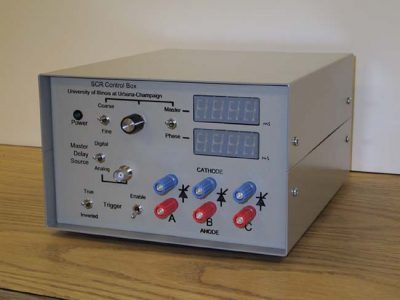
From April to September 2003, Zakdy Sorchini and Jonathan Kimball designed new SCR boxes for laboratory use, with Yong Chen’s assistance. The primary end application is ECE469, Power Electronics Lab, a senior-level lab course at the University of Illinois at Urbana-Champaign. Additionally, it was desired to support features used in research, and to have precision appropriate for research. It was supported in part by the Department of Electrical and Computer Engineering and in part by the Grainger Center for Electric Machinery and Electromechanics.
SPECIFICATIONS:
The boxes contain three SCRs (10RIA40 from International Rectifier on a heat sink), with uncommitted anodes and cathodes available to the user. The trigger source may be internal (from the power supply, derived from the AC power connection) or external (12-120 VAC, typically phase A line-to-neutral). The user has complete control over the master delay and the phase-to-phase delay. This allows operation from an arbitrary frequency source, single-, two-, or three-phase. Trigger inversion is supported, so that two boxes can be used to build a full three-phase bridge. The master delay source may be digital via a manual encoder or analog via BNC connection (0-5 V).
The core timing generation is performed in a microcontroller and CPLD. The microcontroller generates a clock at 200 kHz and pre-loads three timers with the number of clock cycles to delay. When each timer reaches zero, the corresponding SCR is fired with a pulse train that terminates with the start of the next SCR’s firing. The microcontroller also performs user I/O, including two LED-based displays to communicate the delay time.
Additionally, PLL operation is available. In this mode, the display reflects pulses of delay rather than time. Twelve-bit operation is supported. With different jumper settings, the PLL will operate from a source frequency of 50-400 Hz.
DESIGN DETAILS:
The complete design is available in PDF format. Schematic and board layout was performed using the OrCAD suite from Cadence, PSD 14.0. Mechanical design was done in Autodesk Inventor. The estimated material cost of each box is $350, based on one-piece prices from standard vendors. Most components were obtained through Newark, Digi-Key, Allied or Mouser, or when possible directly from stock in ECE Stores. Pulse transformers came direct from Coilcraft, and custom boxes with silkscreening came direct from Hammond. Heat sink machining and some miscellaneous touch-up was done by the ECE Machine Shop. The bulk of the PCB assembly was performed by the Electronics Shop, while final assembly was performed by Zakdy, Jonathan, and Yong.
Copyright © 2004 by Jonathan Kimball, Robert S. Balog, Zakdy Sorchini, Patrick L. Chapman, and Philip T. Krein. All Rights Reserved. May be duplicated for educational use only so long as this notice remains intact.